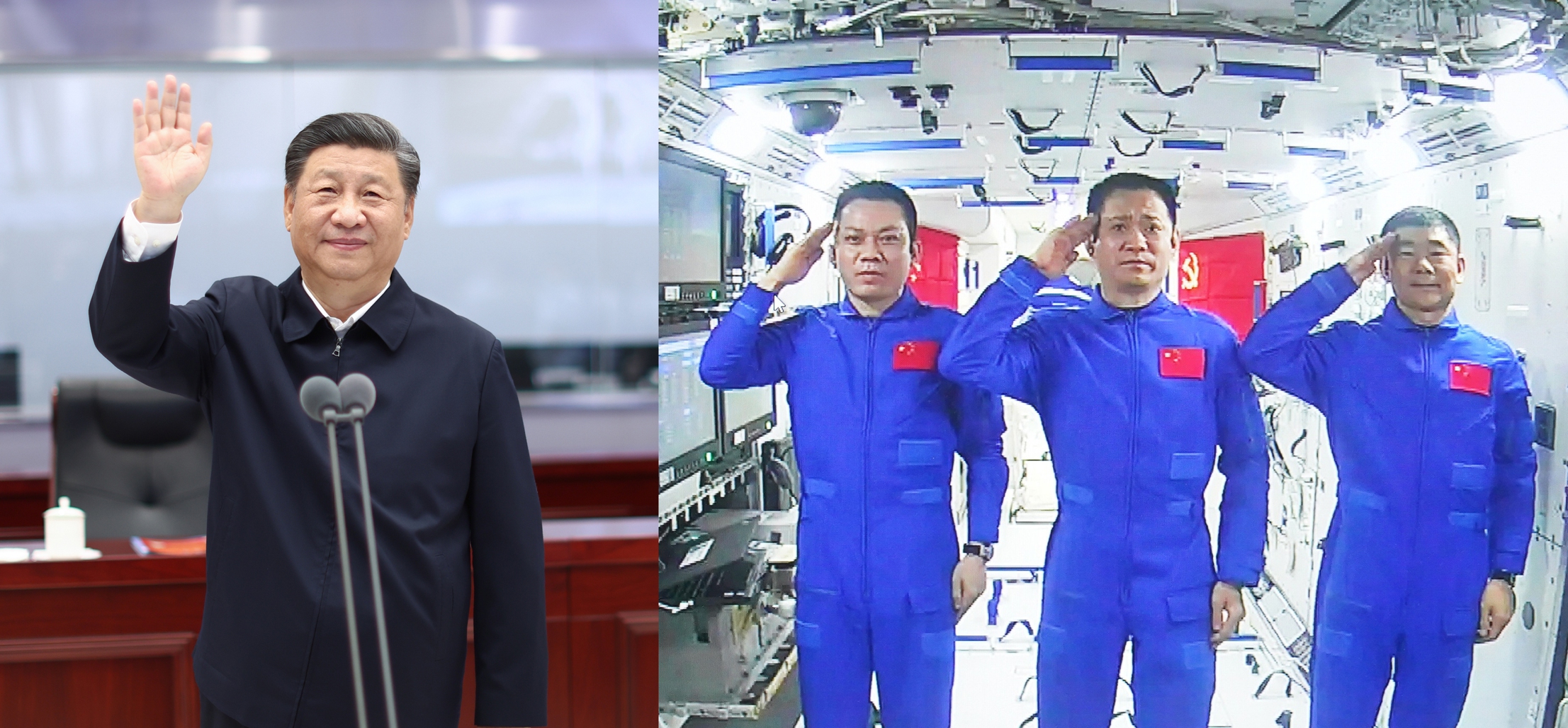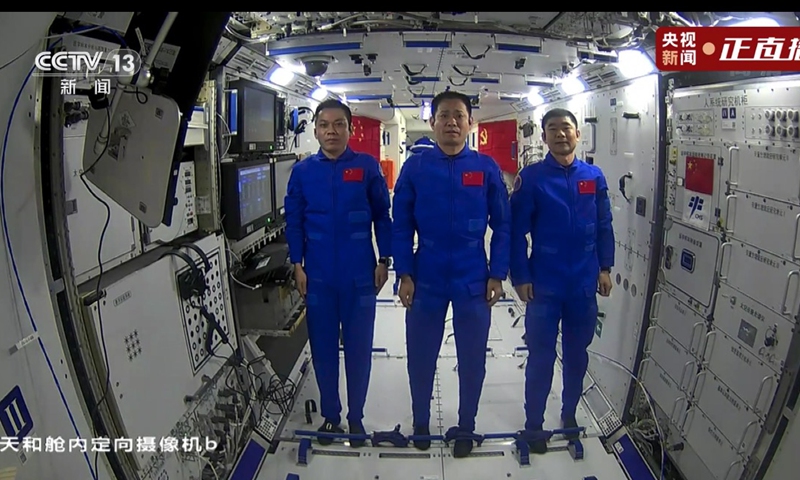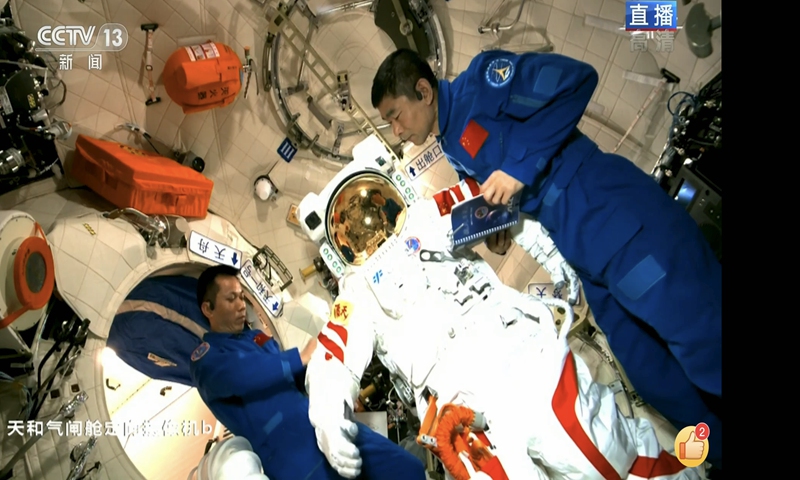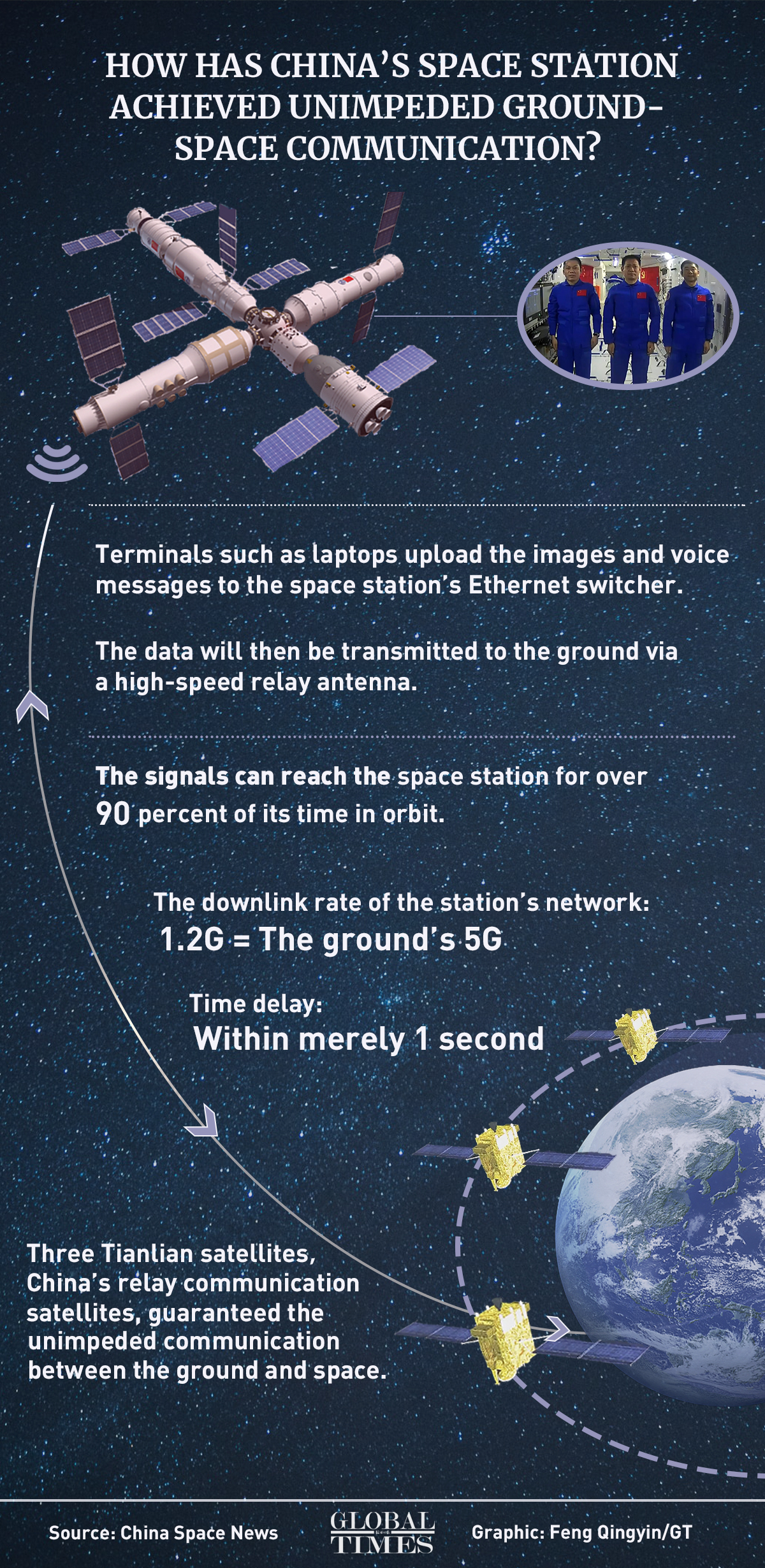
Chinese President Xi Jinping at the Beijing Aerospace Control Center waves to three taikonauts (from left) Tang Hongbo, Nie Haisheng and Liu Boming stationed in the country's space station core module Tianhe on Wednesday. Photo: Xinhua
President Xi Jinping, also general secretary of the Communist Party of China (CPC) Central Committee and chairman of the Central Military Commission, conducted the first ground-space call with the three taikonauts stationed in China's Tianhe space station core module on Wednesday morning.
It took place six days after the Shenzhou-12 crew entered their new home in space on June 17.
At the beginning of the call, which was livestreamed by state broadcaster China Central Television (CCTV), taikonauts Liu Boming and Tang Hongbo were seen making adjustments to a spacesuit expected to be used for future extravehicular activities. Nie Haisheng, the crew leader, was operating the space station system at the working station in the main compartment.
After the three taikonauts gathered at the space station core module's main compartment, standing in front of a Chinese national flag and a CPC flag, they saluted President Xi.
Xi sent warm greetings to them and wished them a successful mission.
Nie said the crew is proud of the great CPC and the country. "We Chinese taikonauts now have a long-term home in orbit," he said.
The call went smoothly.

Photo: screenshot from CCTV
'Heavenly blessings' Given the fact that the three taikonauts are all Party members, some netizens have floated the idea of establishing a space Party branch. According to Party branch work regulations, the number of Party members in space have met the minimum requirements for the establishment of a Party branch - three.
Song Luzheng, a research fellow with the China Institute of Fudan University in Shanghai, said he could understand such a suggestion from internet users because the three crew members are outstanding representatives of the CPC.
Song noted that the crew and the China Space Station program, under the leadership of the Party, will make greater contributions to space exploration for the entire world.
Many are also looking forward to the crew sending blessings from the space station on July 1, the day marking the CPC's centennial.
The three will be in space to celebrate the Party's anniversary, a special tribute to the centennial, Song told the Global Times on Wednesday.

Photo: screenshot from CCTV
Vlog of space lifeCCTV on Wednesday also released the first vlog footage documenting the crew's first 24 hours in China's space station core module.
Tang woke up in the dim resting cabins at 5:40 am, kick-starting his first day in space. The separate sleeping lounges in the space station core module have an independent lighting system, according to CCTV.
After cleaning himself, Tang went to the working area and got down to business.
At around 7:20 am, some packages were already seen floating in the cabin. Tang was using an electronic screw driver to unpack them.
Then the three had their first breakfast in space. At around noon, they had their first lunch.
The crew took a short break after lunch.Tang and Nie floated back to the sleeping area for a nap. And around 2 pm they began their afternoon operations, mainly entering the Tianzhou-2 cargo spacecraft to transfer supplies.
Wearing goggles and carrying tools, Nie entered the cargo vessel assisted by Liu at around 4:30 pm.
After dinner, the three continued to arrange the boxes they had transferred into the core module.
Around 10 pm, they moved back to their sleeping area and called it a day, or called it a night in their case.
According to the China Manned Space Agency (CMSA), the crew will keep a synchronized work and rest schedule between space and Earth.
At 8 am every day, they will be communicating with ground control personnel to be briefed on the day's work plan, and at 8-9 pm, they will be giving updates on their mission.
According to Huang Weifen, chief trainer of the taikonauts, the crew has one hour every day and every Sunday to rest and have their private time.

China's space station achieves unimpeded ground-space communication with a speed equaling to that of the ground's 5G communication. The time delay is within merely 1 second.
Smooth talkThe smooth video and call between Xi and the three taikonauts also impressed many Chinese audience, who are wondering about the technology behind the high-resolution images, clear audio, and a ground-space connection with almost no time delay.
A "space network" composed of three homegrown Tianlian satellites guaranteed the unimpeded communication, according to China Space News, the newspaper co-hosted by two state-owned space giants, the China Aerospace Science and Technology Corporation and the China Aerospace Science and Industry Corporation.
Tianlian satellites are China's data tracking and relay communication satellites. They are mainly tasked with providing data relay, measurements and control, as well as transmission services for the spacecraft.
The downlink rate of the station's space network is 1.2 gigabits per second, which is equivalent to 5G speeds on the ground, and the time delay is merely within 1 second, the system developer told CCTV News.
Yi Yusheng, chief designer of the space station's measurement, control and communication subsystem at the China Academy of Space Technology, said that the taikonauts could hold video calls, send and receiveemails, and even watch online TV programs via the station's telecommunication network during their three-month stay.
"They can also have private phone calls with their families using a special telephone, which will not be heard by any of the ground control staff," Yi said.
Communications on the station go far beyond ground-space talks.
The taikonauts can establish a network link with future Shenzhou spacecraft during their travels to space, or even set up a "group chat" with relevant persons in need, the Shanghai Academy of Spaceflight Technology under China Aerospace Science and Technology Corporation told the Global Times in a statement on Wednesday.
Jing Zheng, deputy commander of the space station, added that the Wi-Fi in space feels the same as the ground, supporting the taikonauts' daily communications on WeChat and video calls.
Over 10 cable and wireless network cameras, Bluetooth headsets, mobile phones, PADs, and laptops had been brought to the Tianhe core cabin to guarantee its connection with the ground.
These terminals will upload the images and voice messages to the space station's Ethernet switch, which will then transmit the data to the ground via a high-speed relay antenna.
A major breakthrough has been made for the relay antenna in that the updated version could be repaired and maintained to extend its life to support the space station's operational needs for 15 years, a system developer said.
Yi of CAST said that the ground-space connection will not be interfered with, as the three Tianlian satellites and the space station's relay antenna could achieve a coverage rate of more than 90 percent, meaning that the telecommunication signals can reach the craft during over 90 percent of its time in orbit.
When the two other laboratory modules are docked with the core cabin and the three-module complex is formed, there will be another two relay antennas that will realize a 100 percent coverage rate of ground-space connection.
Future undertakingsSun Jun, the mission chief of the space station project at the Beijing Aerospace Flight Control Center, said on Wednesday that the first extravehicular activity or spacewalk for the taikonauts is expected to take place in some 10 days.
One key breakthrough of the new spacesuit is that it can support longer spacewalks, increasing from four hours to the current seven to eight hours, media reported, citing Nie.
It is also packed with multiple functions including radiation resistance and a life support system.
Liu, who had participated in the Shenzhou-7 mission in 2008 and assisted Zhai Zhigang, China's first person to spacewalk during the Shenzhou-7 mission, to complete the country's first spacewalk, said that the new suit is more comfortable, and easier to move in.
Liu is expected to play a crucial role during outside cabin operations in the Shenzhou-12 mission, insiders told the Global Times.
"The three crew members have received special training for extravehicular activities ahead of their current travel to space, and they can conduct outside cabin work," Jing said.
He noted that the robotic arms will assist them exiting the cabin, by carrying them with its arms and delivering them to the designated spot outside the cabin, saving a great amount of energy.
The robotic arm onboard China's space station is most similar to human arms, and the most complex and most intelligent system in space, according to media reports. Its maximum loading capacity is 25 tons, capable of moving the space lab modules of the station.
During their more complex and challenging three-month stay, the crew will carry out in-cabin work, including repair and maintenance, appliance switching and scientific operation of payloads.
They are also tasked with multiple in-orbit operations of the Tianhe core module, including verification of the recycling and life support systems, and operation training of the robotic arm, said Ji Qiming, assistant to the director of the China Manned Space Agency earlier.
Two extravehicular activities will be performed during their stay, where they will test the new spacesuits, assemble the extravehicular toolbox, lift the panoramic camera and install extended pump sets.
Two spacesuits, weighing more than 100 kilograms each, were sent to the space station complex via the Tianzhou-2 cargo spacecraft mission in May.







